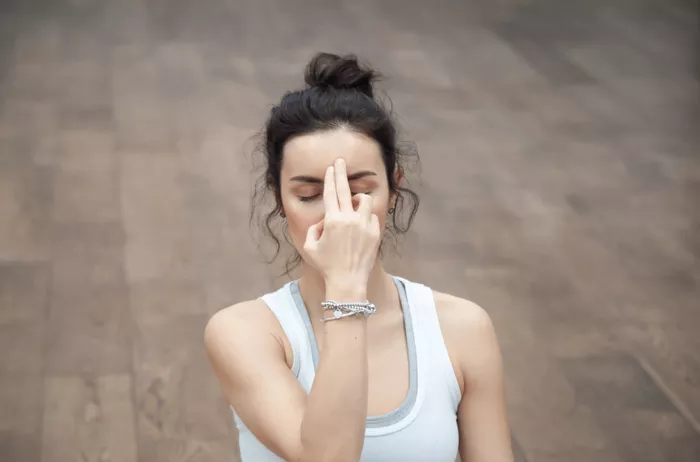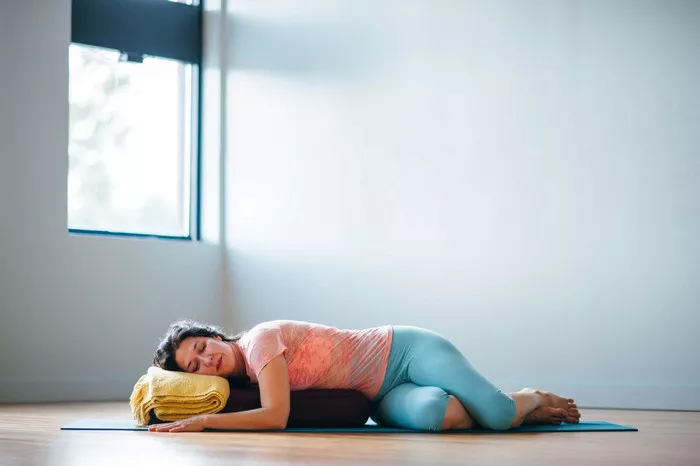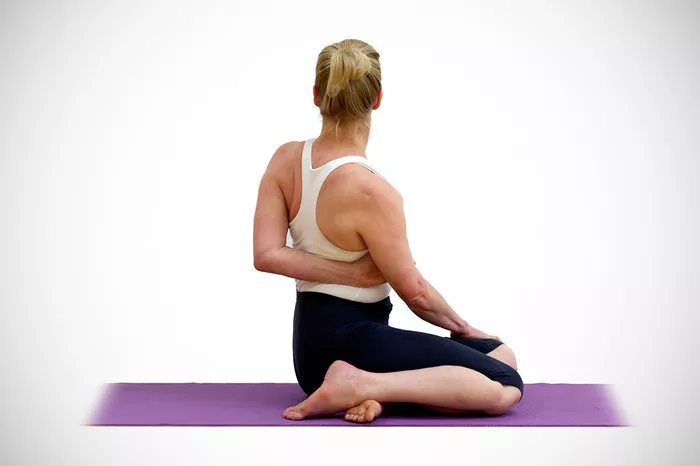Restorative yoga is a gentle form of yoga that focuses on relaxation and healing. It uses props like blankets, bolsters, and blocks to support the body in restful poses. This practice allows for deep relaxation and stress relief. In this article, we will explore the many benefits of restorative yoga, why it is good for you, and how you can incorporate it into your life.
What Is Restorative Yoga?
Restorative yoga is a practice that emphasizes calming the mind and body. It is different from other types of yoga that focus on strength or flexibility. In restorative yoga, the poses are held for longer periods, usually between five and 20 minutes. This allows the body to release tension and relax deeply.
The use of props is essential in restorative yoga. These props help you feel comfortable and supported in each pose. The goal is to allow the body to relax fully, which helps reduce stress and promote healing.
The Origin of Restorative Yoga
Restorative yoga has its roots in the tradition of Hatha yoga. It was popularized in the West by B.K.S. Iyengar and Judith Hanson Lasater. Iyengar introduced the use of props in yoga, which made the practice accessible to everyone. Lasater further developed restorative yoga by emphasizing relaxation and healing. Today, restorative yoga is practiced worldwide and is recognized for its therapeutic benefits.
The Benefits of Restorative Yoga
Restorative yoga offers numerous benefits for both the mind and body. Here are some key advantages:
1. Stress Reduction
One of the primary benefits of restorative yoga is its ability to reduce stress. When you practice restorative yoga, your body activates the parasympathetic nervous system. This is the part of the nervous system responsible for relaxation. As a result, your heart rate decreases, and your breathing becomes slower and more even. This helps to lower stress levels and promote a sense of calm.
2. Improved Sleep Quality
Many people struggle with sleep issues, such as insomnia or restless nights. Restorative yoga can help improve sleep quality. The relaxation techniques used in restorative yoga help quiet the mind and prepare the body for sleep. By incorporating restorative yoga into your evening routine, you can create a peaceful atmosphere that promotes restful sleep.
3. Enhanced Flexibility
While restorative yoga is not primarily focused on increasing flexibility, it can still help improve it. The gentle stretching involved in restorative poses helps release tight muscles and increase range of motion. Over time, this can lead to improved flexibility, especially in areas that may feel stiff or tense.
4. Pain Relief
Restorative yoga can provide relief from chronic pain conditions. The gentle stretching and supported poses help to alleviate tension in the body. Many individuals with conditions like back pain, arthritis, or headaches find restorative yoga beneficial. By focusing on relaxation and gentle movement, you can help manage and reduce pain.
5. Emotional Balance
Restorative yoga promotes emotional well-being. The practice encourages mindfulness and self-awareness. As you relax and focus on your breath, you become more in tune with your emotions. This can help you process feelings, reduce anxiety, and improve your overall mood. Many practitioners report feeling more balanced and centered after a restorative yoga session.
6. Better Breathing
Restorative yoga emphasizes deep, diaphragmatic breathing. This type of breathing helps increase oxygen flow in the body and promotes relaxation. By practicing restorative yoga, you can develop better breathing habits that carry over into your daily life. Improved breathing can lead to increased energy and reduced feelings of anxiety.
7. Enhanced Mindfulness
Mindfulness is the practice of being present in the moment. Restorative yoga encourages mindfulness by inviting you to focus on your breath and body sensations. As you hold each pose, you become more aware of your thoughts and feelings. This practice of mindfulness can extend beyond your yoga mat, helping you cultivate a more present and aware mindset in everyday life.
8. Increased Self-Awareness
As you practice restorative yoga, you become more in tune with your body and mind. This increased self-awareness can help you recognize patterns of tension, stress, or discomfort. By becoming aware of these patterns, you can make more conscious choices to support your well-being. This heightened self-awareness can lead to a more balanced and fulfilling life.
9. Improved Circulation
Restorative yoga can improve blood circulation throughout the body. The gentle movements and supported poses promote better blood flow to the organs and tissues. Improved circulation can enhance overall health and vitality, making you feel more energized and alive.
10. Deep Relaxation
One of the most notable benefits of restorative yoga is its ability to induce deep relaxation. The long-held poses and supportive props create a space for your body to let go of tension. This deep relaxation can help reduce muscle tension, calm the mind, and promote overall well-being.
How to Practice Restorative Yoga
Practicing restorative yoga is accessible to everyone, regardless of experience level. Here are some tips to help you get started:
1. Create a Comfortable Space
Find a quiet and comfortable space where you can practice. Use soft lighting and create a peaceful atmosphere. You may want to play calming music or use essential oils to enhance your practice.
2. Gather Your Props
Having the right props is essential for restorative yoga. You will need:
Yoga mat: A comfortable surface to practice on.
Bolsters: These provide support for your body in various poses.
Blankets: Use blankets for extra cushioning and warmth.
Blocks: Blocks can help support your body in different poses.
Strap: A strap can assist with stretching and support.
3. Choose Your Poses
Select a few restorative poses to practice. Here are some popular options:
Supported Child’s Pose: Kneel on your mat and place a bolster or blanket in front of you. Rest your forehead on the support and relax your arms at your sides.
Reclining Bound Angle Pose: Lie on your back and bring the soles of your feet together, allowing your knees to fall open. Use blankets or bolsters under your knees for support.
Supported Bridge Pose: Lie on your back with your knees bent and feet flat on the floor. Place a bolster under your sacrum for support, allowing your hips to relax.
Legs-Up-the-Wall Pose: Sit next to a wall and swing your legs up onto the wall while lying on your back. This pose promotes relaxation and improves circulation.
4. Focus on Your Breath
As you settle into each pose, focus on your breath. Take slow, deep breaths, allowing your body to relax with each exhale. You may find it helpful to count your breaths or repeat a calming mantra to help maintain your focus.
5. Hold the Poses for Several Minutes
Restorative yoga poses are typically held for five to 20 minutes. Listen to your body and stay in each pose for as long as you feel comfortable. Use props to support your body and make adjustments as needed.
6. Transition Slowly
When it’s time to come out of a pose, do so slowly and mindfully. Take your time and notice how your body feels as you transition to a seated position or another pose.
7. Practice Regularly
Incorporate restorative yoga into your routine regularly. Even a short session of 20 to 30 minutes can be beneficial. Aim for at least once a week, or more often if possible.
Restorative Yoga and Mental Health
Restorative yoga can have profound effects on mental health. Here are some ways it can help:
1. Anxiety Relief
Many individuals experience anxiety in their daily lives. Restorative yoga provides a safe space to explore and release these feelings. The calming poses and focus on breath help reduce anxiety symptoms, promoting a sense of peace and relaxation.
2. Depression Management
Restorative yoga can be a valuable tool for managing depression. The practice encourages mindfulness and self-compassion, allowing individuals to connect with their emotions in a safe way. This connection can foster healing and emotional well-being.
3. Trauma Recovery
For those who have experienced trauma, restorative yoga can be a healing practice. The gentle movements and focus on breath create a safe space for processing emotions. Many trauma survivors find restorative yoga helpful for building resilience and coping with their experiences.
See Also: Self-Restorative Yoga: A Path to Healing and Rejuvenation
Restorative Yoga for All Ages
Restorative yoga is suitable for all ages and fitness levels. Here are some considerations for different age groups:
1. Children
Restorative yoga can be a wonderful practice for children. It helps them learn to relax, manage stress, and develop mindfulness skills. Simple poses and playful elements can make the practice enjoyable for kids.
2. Seniors
Seniors can greatly benefit from restorative yoga. The gentle nature of the practice makes it accessible for those with limited mobility. Restorative yoga can help improve flexibility, balance, and overall well-being in older adults.
3. Pregnant Women
Pregnant women can also practice restorative yoga, with some modifications. Poses that promote relaxation and support the body are particularly beneficial during pregnancy. Always consult a healthcare provider before starting any new exercise routine during pregnancy.
Conclusion
Restorative yoga is a powerful practice that offers numerous benefits for both the mind and body. From stress reduction and improved sleep quality to enhanced flexibility and emotional balance, restorative yoga can positively impact your overall well-being. By incorporating this gentle practice into your routine, you can cultivate a greater sense of peace, self-awareness, and relaxation in your life.
Whether you are a beginner or an experienced practitioner, restorative yoga can be a valuable addition to your wellness journey. So, roll out your mat, gather your props, and take a moment to embrace the calming benefits of restorative yoga. Your mind and body will thank you.
You Might Be Interested In
















